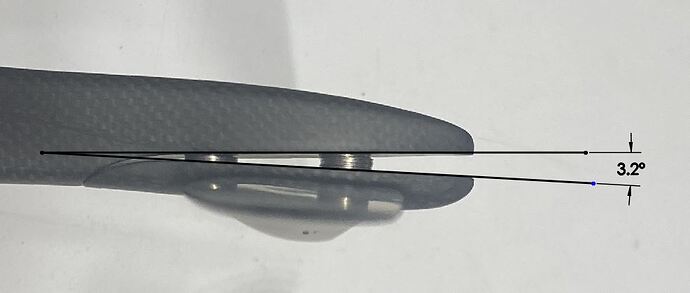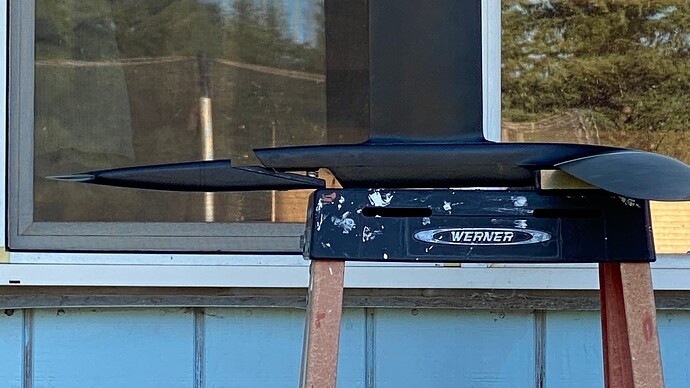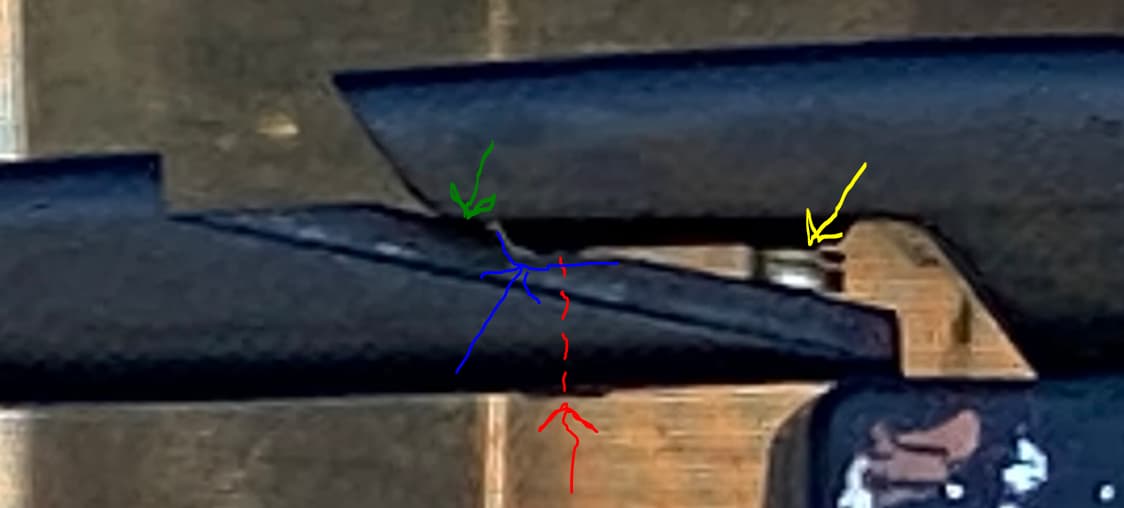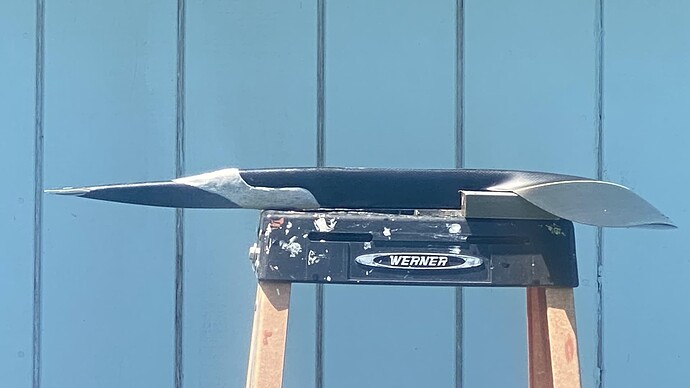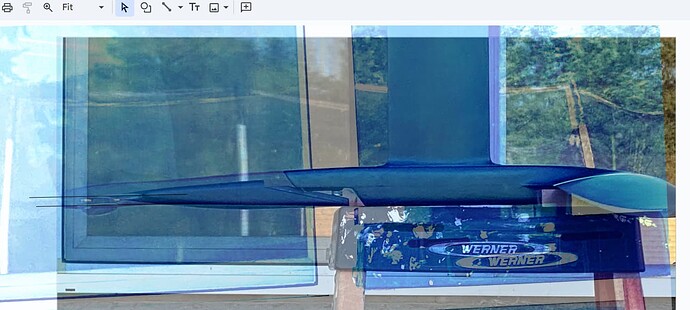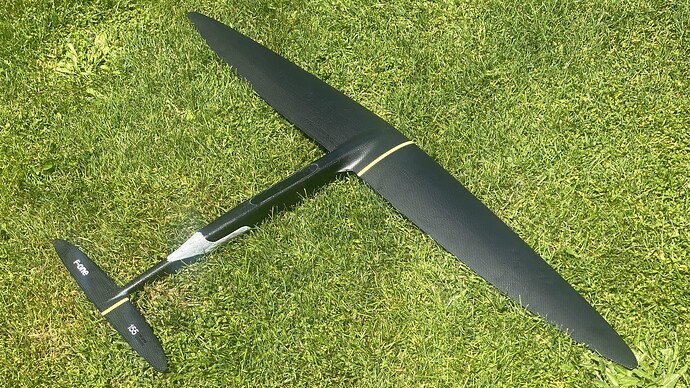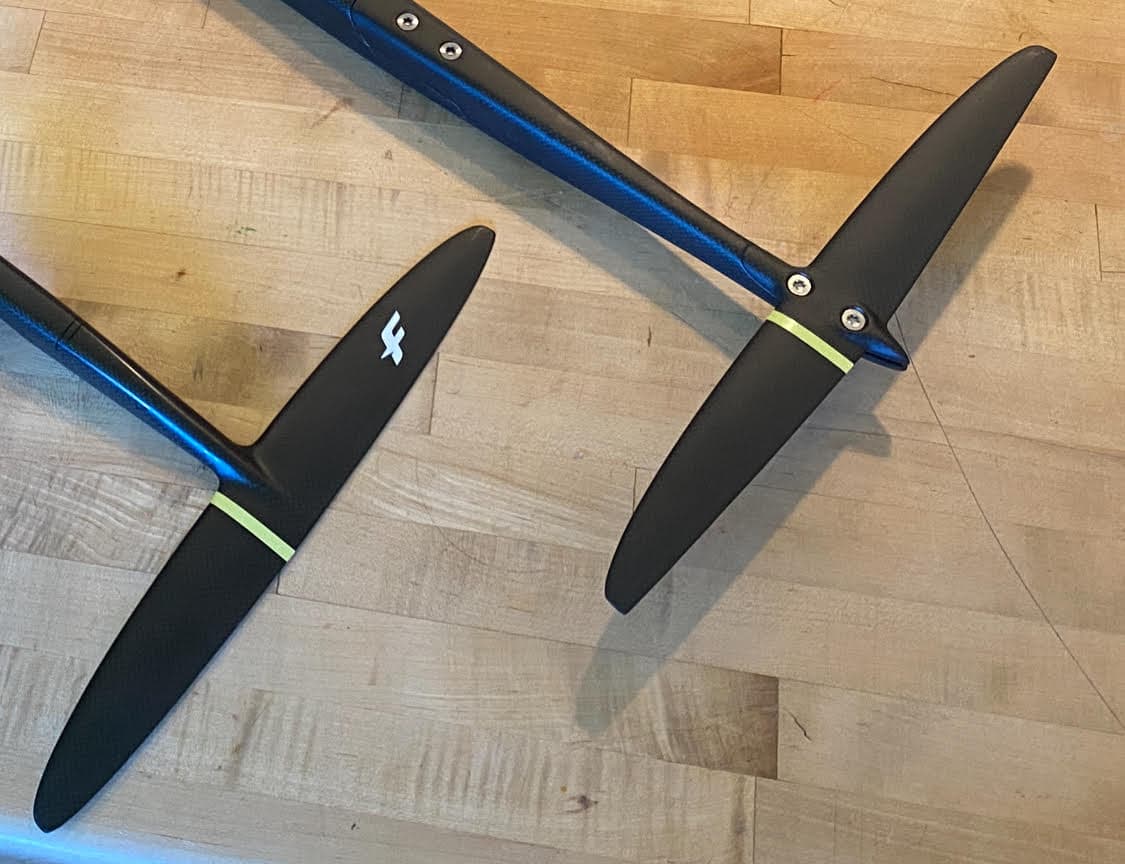I’ve been dockfoiling Axis for 5 years, 1120, 1150, 1310, 1300, 1401, and the last 2 years dockfoiling just with the 1201. I don’t wing (anymore) and am slowly learning to SUP downwind, 99% of my foiling days I am at the dock. I want to share my experience switching from the Axis 1201 to the Code 1250R, I mod alot of my gear and the Axis 1201 setup is heavily modded, I started riding the Code 1250R stock and have 1 week on the Code 1250R and will first share this experience.
I rode the Code 1250R starting with the long fus and 135R tail and no shim and switched right away to the short fus which was much better. I was riding the Code 75cm high modulus carbon mast. I bought the Code 1250R front wing and was demoing all the other Code gear as I knew I would not use the other Code gear down the road as I make and mod alot of my own gear, Chris Shay at Doug’s Sports in Hood River was super cool and supportive selling me the 1250R and letting me demo all the other Code gear. I was never sponsored by Axis and am not sponsored by Code and I buy all my gear retail or used, I like buying gear retail and it supports the brands and then I can say what I want and do what I want, I tend to ride the same foil and mod it for 1 or 2 years so I don’t go thru much gear anyway, lots of fun hours riding and fun hours modding for very little money (compared to playing golf or whatever). I’m 60 year old, pretty fit 6’4" (193cm) and 195 lbs (88kg) I’ll try and break this information into smaller posts so its easier for people to read, keep track of what is new and reply and quote from shorter posts too.
The first thing I noticed was the Code 1250R (long fus, 135R tail, no shim, 75cm high mod mast) was super easy to ride, maybe 3X easier to balance and steer then the Axis 1201. I compared the stiffness of the my 1201 setup to the 1250R setup and everything was comparable except the up and down wingtip flex which was maybe 8X floppier (didn’t measure this) on the 1201 then the 1250R. I think this was the main culprit, especially for heavier riders pumping while dockstarting where you have to pump really hard that the 1201 wingtips flex up quite a bit and this changes the stability as it changes the wing tips from drooped (more stable) to flat (less stable) or even flexed up (very unstable). One has to remember that when pumping the wing probably sees a max of 3g’s so this means the wing is lifting 3x my weight at the max pumping pressure so that’s alot of load on the wings. The only other difference from a stiffness standpoint was I had modded the Axis rear fus making it more flexy, although faster and easier to pump so maybe this had an effect too. I switched right away to the short fus and this felt better and livelier and still like 3X easier to ride than my 1201 setup. It’s hard to describe how the handling was better with the 1250R, the 1201 turns nicely (for dockfoiling), its just pretty hard to balance on. I got like 90% of my starts on the 1250R and it was brand new to me and I get only 50% to 75% of my starts with the 1201 after riding it for 2 years and it seemed like I could ride the 1250R 50% longer with the same effort so like 90 seconds instead of 60 seconds and they were similar speed, maybe the 1250R slightly slower.
What was your 1201 fuse and stab? Axis tends to make up for lack of maneuverability in front wings with overly short stabs which works but it’s very pitch unstable and takes rider skill to counter. This makes for much more challenging starts in general.
Also the 1201 is a challenging wing to start, needs a bunch of speed and several steps to get there.
I borrowed a 1250R the other day and it is a nice all around dock setup if you don’t value rock starts. It just needs a bit more speed than I’d like to do static starts with. It’s definitely faster than the 1201 and more efficient and has better glide and better low end though. There is something really crisp and rewarding about the 1201 pump when you get it just right though. I also think the 1201 turns as good as the 1250R.
Were you able to demo the code plus mast vs the regular mast? In theory, Code might suggest your weight and the wider span 1250 wing would be well suited to the stiffer version. Thanks for sharing your experience
That’s not surprising.. even if axis copies the R wing like they have been doing with the fireball, the difference is in the monobloc and non monobloc construction. If you look at axis it’s like chopping your arm in half and then putting a plate with screws back on it and saying yeah it should feel the same like a normal arm that’s solid.
I had a similar experience proning from Axis/AFS → Code.
Code feels easier, more stable, less pitchy, requires less efforts to remain balanced, and yet, it’s not locked, when you want to turn, you can actually turn with precision and control.
At first I thought that Code was feeling a bit “dead”, dull.
Then you realise it just wants you to push it hard, and it works extremely well because it’s stiff, predictable and with a stable behavior whatever the speed.
I don’t doubt there are more playful or surfy foils, but Code just feels healthy.
would be great to have a comparison of the 1250r and fireball 1250
which AFS are you comparing to the Code? I feel the Enduro 900 compares very closely to the 860R.
On topic for this thread, I’d love to hear if anyone has dockstarted the 1250R alongside the AFS Enduro 1300. I found the 1300 incredibly better than the Axis 1201, but I haven’t got to try the 1250R yet
I did Enduro1100 → Code 980s.
E1100 had more glide.
Appart of that, I found the Code better in every aspect, even in pumping despite its lower size.
I also have the Axis AP1201, I have never liked the ride (feels technical, not fun) but it pumps very well in straight line. Reports are saying that the Axis Fireball 1350 is better in every way than the AP1201, so that would be the benchmark VS the Code 1250R.
The 1250R compares to the 1350 Fireball. The 1075R would better compare to the 1250 Fireball.
Shimming the Code 1250R tail vs the Axis 1201 - Once I could ride around on the 1250R stock with no tail shim, I wanted to shim the tail with some washers. I could feel the tail pushing the front wing up on the 1250R which initiates the pump without me doing anything which is usually how foils are set up for beginners so this made sense with the stock flat no shims tail (135R tail and short fus). I started adding washers to the rear screw which moved the trailing edge of the tail down, I added more and more washers, doing 2 runs each time to get the feel of the shims and it felt better and better, less front wing up force and more glide and speed although I did have to initiate the pumps more on my own. Finally at +5 rear washers and 3.2 degrees trailing edge down it got squirrely and a bit hard to ride though still easily doable (see pic)
I backed off from this to only +4 washers in the back which was 2.56 degrees trailing edge down. I was shocked by how much angle it took to go from stock flat to where I liked it and also shocked by how differently the Code 1250R responded to tail shims compared to what I was used to riding the Axis 1201 (360/45 skinny tail and Adv+ Ultrashort Fus). When I shimmed the Axis 1201 more tail down it got faster and glidier very quickly and then super fast and glidey and then super hard to ride and balance on in like only 1.4 degrees. Compared to how I shimmed the 1250R it took like 2X more angle change to get the same effect and the 1250R responded much “slower” to the tail shims, almost like the 1250R “didn’t care” that I was shimming the tail. I believe this is because the Axis 1201 with its straight median line (the 1/4 chord point of the airfoil section stays the same distance from the tail all the way from fus to wing tip) means there is no stability built into the front foil and almost all the stability comes from the tail (some comes from the fus just being there), this means as you tune down the trailing edge of the tail you are turning all the stability off and when its off its really off, you get awesome glide, super slippery handling and hardly any effort needed to pitch up or down the front wing, its also hard to balance in this mode, your feet have to be exactly in the right position. This is very different than the 1250R where when I tune down the trailing edge of the tail, the front wing still felt stable, felt a bit “mushy” and always I need to push it up or down. I believe this is because the 1250R front wing has quite a bit of stability built right into the front wing unlike the Axis 1201, for sure the 1250R swept wingtips add stability (the 1/4 chord point of the wing sections rake back going from the fus to the wing tips) and it seems there is some twist too on the outer 1250R wingtips which would add in stability too. None of this is good or bad, merely design choices that result in different foil “feels” and that require different riding styles. For example when I was dialing in my Axis 1201 using the very cool Axis shim kit, I felt there was too big a jump using the +/- 0.25 degree shim so I made my own 1/8 degree shim to get the foil right where I liked it. I am sure by comparison I would not be able to tell at all for +/- 1/8 degree on the Code 1250R if it affected anything. Even though the Code 1250R has more stability baked into it, I still like it and I know from past projects that as I modify things to reduce drag like the mast fus interface and the fus cross section details that these mods will take away stability too, so I forsee the modded Code 1250R being more and more awesome as it should get looser as I start to do mods.
Interesting stuff Wes!
I’m about the same weight and height and have tons of time on the 1075R / 135 combo. Very curious about the 1250R as well. Never once thought about shimming the 135R tail either way though. I’ve only used it for DW supfoiling, winging and parawinging so maybe flat water pumping highlights the pitch stability more. Or maybe the 1250 has a slightly different AOA.
I’m curious where your back foot ends up riding it this way relative to the mast?
As a side note I’m noticing the 980S / 135R combo is more noticeably board nose up-centric than any of the R series I’ve tried. In no way lacking for glide like this, just noticeably different to the R series foils w/ the same tail.
Here is a picture of me riding the 1250R with the tail shimmed 2.56 degrees trailing edge down from stock (no shim). Maybe in the future I can get pics of different foot position with different shims. I believe both of my feet would be about 1/2" further forward if there was no shim in the tail.
I picked the Code 1250R because of the great reviews and because I wanted a monobloc front wing though I also wanted a monobloc rear fus and tail so I was thinking how to modify a different brand. I ended us modifying an F-One 155 XXS DW monobloc tail so that it could bolt on to the Code 1250R fus.
I thought it would be very complicated and it ended up being pretty simple as the Code 1250R has two holes that have treaded inserts in it and the F-one tail already has one countersunk thru hole in a good position so I just needed one more thru hole in the F-one tail.
I added a new countersink thru hole to match up with the rear 1250R hole (Red Arrow and dashed line) and wanted the F-One tail to touch down at the green arrow point so I sanded a notch in the F-One tail where the blue arrow and blue outline are, then to get the tail pitch I wanted I added some washers to the front screw (yellow arrow). It seemed pretty sturdy just with the two bolts and I wanted to try it right away so I decided to try adding in plastic based modeling
clay to fill in the joint and smooth things out. Here is a pic showing the white modeling clay filled in
I overlayed two photos in Google drawings to check the tail angles of the stock Code tail at 2.56 degrees trailing edge down and the new F-One tail and it looked really good.
Here is another picture of the moded F-One tail add on
I have ridden it 4 days at the dock and the F-One tail is noticeable easier to pump and has noticeably less drag, better acceleration and overall 5% easier to keep going which is alot to come just from the tail. Here is a pic showing the F-One tail and the stock Code 135R tail. Because the stock Code 135R tail has screws heads and a joint, the fus where it comes into the tail needs to be much thicker and the extra meat where the screws go down inside the fus makes this part the of Code tail much wider than the F-One tail, all of these things I believe contribute to more drag from the Code tail which is even more noticeable when pumping as the tail angle of attack is changing so much so quickly vs just riding more straight when like wing foiling.
I plan to do a more permanent mod with carbon fiber or maybe 3d printing to be able to try different F-One tails and different shim angles, will see how that goes.
Wish code made 120r monobloc tails like fone.
